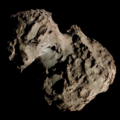C/1941 B2 (de Kock–Paraskevopoulos)
 The comet on 16 February 1941 by Yerkes Observatory | |
| Discovery[1][2] | |
|---|---|
| Discovered by | Reginald Purdon de Kock John S. Paraskevopoulos |
| Discovery date | 15 January 1941 |
| Designations | |
| 1941 IV, 1941c[3] | |
| Orbital characteristics[4] | |
| Epoch | 1941-Feb-15.0 |
| Observation arc | 241 days |
| Aphelion | 1,760 AU |
| Perihelion | 0.79 AU |
| Eccentricity | 0.9991 |
| Inclination | 168.2° |
| 43.1° | |
| Argument of periapsis | 268.7° |
| Last perihelion | 27 January 1941 |
| Physical characteristics[5][6] | |
Mean radius | 1.31 km (0.81 mi)[a] |
| Comet total magnitude (M1) | 6.0 |
| 2.0 (1941 apparition) | |
Comet de Kock–Paraskevopoulos (also known with the designations C/1941 B2, 1941 IV, 1941c) is a non-periodic comet discovered on 15 January 1941. The comet reached an apparent magnitude of about +2.[6]
Observational history
[edit]The comet was first observed by Reginald Purdon de Kock in Paarl, South Africa while he was observing variable star R Lupi on 15 January 1941 and notified the Royal Observatory. He estimated the comet had a magnitude of 5.8 and its tail was half a degree long.[7] The comet was independently discovered by Frank Skjellerup in Melbourne on 20 January and confirmed the discovery the next day, while a person named Barnes also notified Melbourne Observatory about the comet on 21 January.[7] John S. Paraskevopoulos of the Harvard College Observatory in Bloemfontein, unaware of the other discoveries, found the comet on 23 January and sent immediately a radiogram in Harvard College, and thus the comet became known in the United States as comet Paraskevopoulos.[7]
The comet brightened rapidly to a magnitude of 2 to 3 the next days, while its tail was reported to be about 5 degrees long. The comet reached its perihelion on 27 January and two days later was the closest approach to Earth, at a distance of 0.2655 AU. On 27 January the comet also reached its southernmost declination, at -57°.[7] On that day, Harley Weston Wood reported a magnitude of 3.26 at a tail length of 5° by naked eye. The comet brightened a bit more the following days, with Ronald Alexander McIntosh reporting magnitude 2.2 and a tail length of 6 degrees on 31 January.[7]
In February the comet began to fade, as it was moving away both from Earth and the Sun.[7] The tail appeared bent the first days of the month. By the mid of February the comet had faded to a magnitude of about 5 and stopped being visible with naked eye.[8] In March the solar elongation decreased and the comet passed 0.6 degrees from the Sun on April 28. The comet was recovered on 4 July by George van Biesbroeck and was last detected on 27 September 1941.[7]
References
[edit]Notes
[edit]Citations
[edit]- ^ J. S. Paraskevopoulos (25 January 1941). E. Strömgren (ed.). "New Comet Paraskevopoulos (1941c)". IAU Circular. 845 (2).
- ^ R. P. de Kock (20 March 1941). E. Strömgren (ed.). "Comet Paraskevopoulos (1941c)". IAU Circular. 856 (3).
- ^ "Comet Names and Designations". International Comet Quarterly. Retrieved 19 June 2025.
- ^ "C/1941 B2 (de Kock–Paraskevopoulos) – JPL Small-Body Database Lookup". ssd.jpl.nasa.gov. Jet Propulsion Laboratory. Retrieved 21 August 2023.
- ^ a b J. A. Fernández; A. Sosa (2012). "Magnitude and size distribution of long-period comets in Earth-crossing or approaching orbits". Monthly Notices of the Royal Astronomical Society. 423 (2): 1674–1690. arXiv:1204.2285. doi:10.1111/j.1365-2966.2012.20989.x.
- ^ a b "Brightest comets seen since 1935". International Comet Quarterly. Retrieved 21 August 2023.
- ^ a b c d e f g G. W. Kronk (2009). Cometography: A Catalogue of Comets. Vol. 4: 1933–1959. Cambridge University Press. pp. 126–132. ISBN 978-0-521-58507-1.
- ^ J. E. Bortle (1998). "The Bright Comet Chronicles". International Comet Quarterly. Retrieved 19 August 2023.




